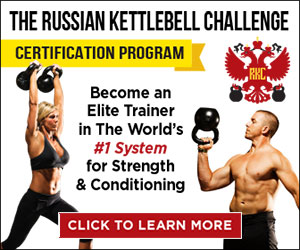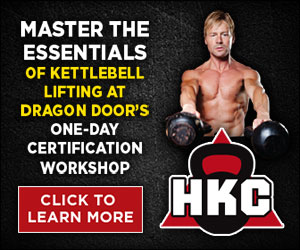Adrienne Harvey, RKC: So how did you first discover kettlebells?
Tim Shuman, RKCII: I got a flyer from John DuCane. He sent me a flyer saying I can get Enter The Kettlebell and two 16Kilo kettlebells for about $109. And apparently he’d gotten my name off an e-mail list when I was using Pavel’s bodyweight books, Power to the People, From Russia with Tough Love, those types of things.
Adrienne Harvey, RKC: What year was that?
Tim Shuman, RKCII: 2008.
Adrienne Harvey, RKC: What’s your favorite thing about kettlebell training?
Tim Shuman, RKCII: Quick, effective, and simple. Just your basics. No flash. It’s just a hunk of black iron that you utilize to wear yourself out.
Adrienne Harvey, RKC: It definitely does that. Now you just recently got your RKC Level 2 certification. Does your certification have any special meaning to you? I guess how do you feel about it? What made you consider going for the next level?
Tim Shuman, RKCII: Definitely major meaning because it’s not the easiest thing to do in the world. The RKC cert is definitely the hardest thing I’ve ever had to do. This is RKCII. A little bit easier but still something very mentally and physically and emotionally draining. Mainly the whole the idea of the RKC is to break you down to the bare minimum so you learn – and you can do it no matter what. It involves a lot of military aspects that way, special forces training and that idea. The RKCII, I wanted to do after realizing I really wanted to teach instructors. It’s the next progression up the ladder to be able to do that. And then also it definitely separates you from anybody else.
Adrienne Harvey, RKC: How have your RKC experiences changed you as a trainer?
Tim Shuman, RKCII: First of all, I’m not a trainer. I’m a strength coach. Big difference. It’s changed my mentality as far as the bells and whistles, all olympic power. Now it’s more kettlebelling. Getting away from the dumbbells. Getting away from the barbells. Getting away from the machines, which I rarely use anyway. But just grab the kettlebell and just go to town.
Adrienne Harvey, RKC: You trained me for the RKC we just had here in Orlando this past October, can you tell me about what you had in mind when you were creating the RKC prep workout program that you made for me?
Tim Shuman, RKCII: Just like what kettlebells are, as simple as it gets, I just wanted to make sure you were prepared. Technique-wise I wanted to make sure you were there as well as your endurance. Nobody is ever going to be able to really train for the volume of the endurance requirements of an RKC cert so you just do what you can. But the biggest thing is make sure the form is there. Make sure the technique is there and everything else will fall into place.
Adrienne Harvey, RKC: You were an instructor at the Orlando RKC this past October, what’s some advice that you would give to future RKC candidates?
Tim Shuman, RKCII: As an assistant instructor, first and foremost, be prepared. We had four people show up that were not prepared at all to do the certification. We had people that were dropping the second day because they were in no shape whatsoever. We had a few people show up and had no idea what the testing procedures were. So first and foremost, be prepared. Go find an RKC. Get your form and technique checked out. Better yet go and attend a pre-certification workshop. Make sure you can perform what’s required because there’s no point in spending the money then coming and wasting your time and the group’s time.
Adrienne Harvey, RKC: How has kettlebell training affected your life?
Tim Shuman, RKCII: It’s definitely changed my training regimen. It used to be purely Olympic lifting, explosive vertical power. Now it’s explosive ballistic power in an arc motion. I rarely ever touch dumbbells. I still use barbells for heavy movement. Otherwise it’s all kettlebell.
Adrienne Harvey, RKC: You run the OrlandoKettlebells.com Fitcamp here in Florida on Monday, Tuesday, and Thursday nights. Can you tell me about the goals behind a typical session of Fitcamp? What do you have in mind when you create the workouts?
Tim Shuman, RKCII: Movement practice. Helping these people move properly under load. The base of the program starts out with a strength segment, a power segment, and a ballistic segment (cardio segment). Including core work. But the main goal is what the individual wants. I’ve got somebody who wants to shed weight. I’ve got some who increase strength. They both work together. While you increase strength, you increase lean muscle mass, which in turn will increase your metabolism. With that you burn more calories at rest which will shed the pounds. So it all factors into together. The biggest thing is to make sure everybody’s enjoying themselves as they’re getting this movement practice in, so they keep going.
Adrienne Harvey, RKC: What would be a favorite workout of yours?
Tim Shuman, RKCII: Anything double kettlebells. Double bells are not just for mind blowing explosive power anymore. They can be cardio workouts.
Adrienne Harvey, RKC: That’s true.
Tim Shuman, RKCII: As you’re moving heavy weight your heart rate is flying. You get your heart rate up around 80, 90 percent you’re burning calories. The heavy weight will force lean muscle to grow. Which in turn will increase your metabolism and burns more calories at the end. But really I just like lifting heavy things and you need two kettlebells to do that.
Adrienne Harvey, RKC: I remember at RKC we would learn an exercise with one kettlebell and then we’d add the second one and it’s almost like a completely different exercise at that point.
Tim Shuman, RKCII: Well, 90 percent of the time you’re doubling your weight, unless you drop down from your practice bell at the time.
Adrienne Harvey, RKC: And if there were any form problems they would really show up at that point.
Tim Shuman, RKCII: Yes, you will quickly find muscle imbalances.
Adrienne Harvey, RKC: What’s the most dramatic physical or mental transformation you’ve seen with a client training with kettlebells?
Tim Shuman, RKCII: I had one of my girls, an internet client, call me and say she dropped a whole pant size from just 10 minutes of swings a day.
Adrienne Harvey, RKC: Wow.
Tim Shuman, RKCII: I’ve had people rehab knees, rehab back, shoulders. I’ve got one guy who has four strands of fiber left on each of his rotator cuffs. He was supposed to get surgery in January, I’ve had him swinging and doing get ups, program minimum. The doctor has put off surgery because his shoulder stability has increased. It’s been a year, he was supposed to get both shoulders cut to fix his rotators. But everybody’s different so it’s a wide variety of transformations.
Adrienne Harvey, RKC: What’s your favorite way to introduce the kettlebell to a new client?
Tim Shuman, RKCII: I just start with the basics and go with a swing and get ups. Clean, press, front squat. Snatch if they can get there. But, you start from the beginning breaking down the swing, deadlift, explosive jump through the heels and the hike. Then you progress into the swing.
Adrienne Harvey, RKC: So Tim, why did you choose RKC instead of some of the other programs available for instruction?
Tim Shuman, RKCII: The majority of the other programs used kettlebells as an element of their program and it’s pretty much just, “All right. Go do a bunch of these and those and the other thing from the list on the board and we’ll finish. When you’re done you can leave.” RKC is actually the gold standard of kettlebell training and it is all about kettlebells. When we say kettlebell, we mean strength. When we say strength, we mean kettlebells. That’s the whole point. It’s not, “Let’s do 20 of these and 50 of those and then, “Oh yeah by the way, let’s thrown in a couple of swings.” RKC does set the standard. And it’s the gold standard so why not go for the best?






Leave a Reply